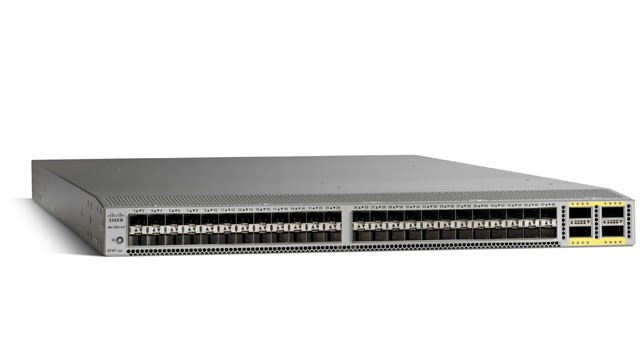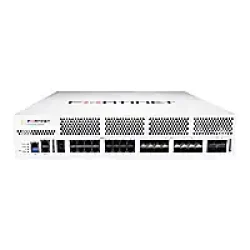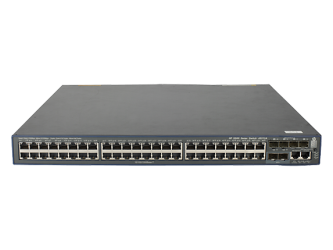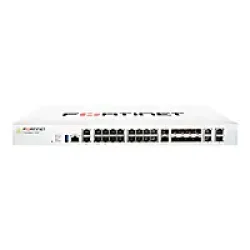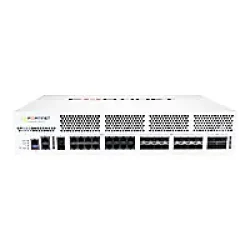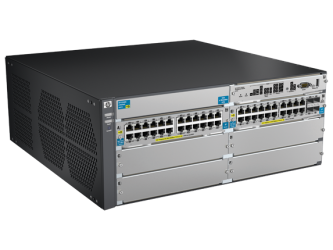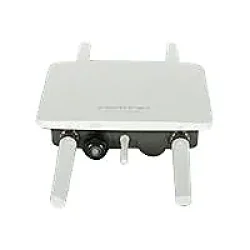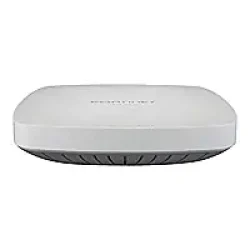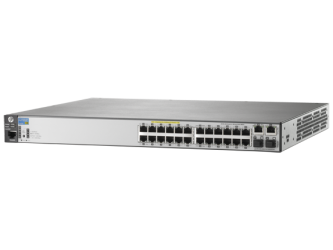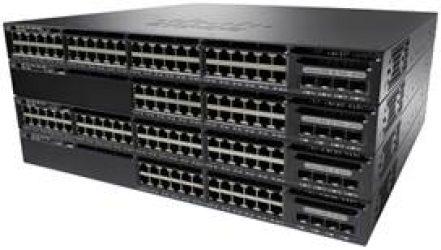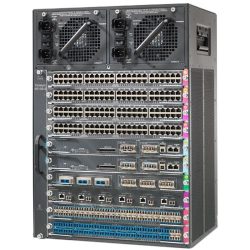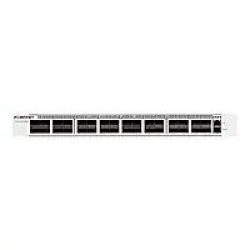Performance
â— Cisco Nexus 6001: Layer 2 and 3 hardware forwarding at 1.28 Tbps
â— Support for up to 256,000 combined entries of MAC addresses and APR entries
â— Low-latency of approximately 1 microsecond using cut-through forwarding for predictable, consistent traffic latency regardless of packet size, traffic pattern, or features enabled on 40 and 10 Gigabit Ethernet interfaces
â— 25-MB buffer per 3x 40 Gigabit Ethernet QSFP interfaces
â— Line-rate traffic throughput on all ports
Interfaces
â— Cisco Nexus 6001P: 48 fixed 1/10 Gigabit Ethernet SFP+ and 4 fixed 40 Gigabit Ethernet QSFP+ports, with 10 and 40 Gigabit Ethernet FCoE support on all respective ports
â— Cisco Nexus 6001T: 48 fixed 1/10 Gigabit BASE-T and 4 fixed 40 Gigabit Ethernet QSFP+ ports, with 10 and 40 Gigabit Ethernet FCoE support on all respective ports
â— 40 Gigabit Ethernet ports can be converted to 10 Gigabit Ethernet interfaces through QSFP+breakout cable
â— Fabric extension through the Cisco Nexus 2200
Layer 2 Features
â— Layer 2 switch ports and VLAN trunks
â— IEEE 802.1Q VLAN encapsulation
â— Support for up to 4000 VLANs
â— Support for up to 4000 access control list (ACL) entries
â— Rapid Per-VLAN Spanning Tree Plus (PVRST+) (IEEE 802.1w compatible)
â— Multiple Spanning Tree Protocol (MSTP) (IEEE 802.1s): 64 instances
â— Spanning Tree PortFast
â— Spanning Tree root guard
â— Spanning Tree Bridge Assurance
â— Cisco EtherChannel technology (up to 16 ports per EtherChannel)
â— Cisco vPC technology
â— vPC configuration synchronization
â— vPC Shutdown
â— Link Aggregation Control Protocol (LACP): IEEE 802.3ad
â— Advanced PortChannel hashing based on Layer 2, 3, and 4 information
â— Jumbo frames on all ports (up to 9216 bytes)
â— Pause frames (IEEE 802.3x)
â— Storm control (unicast, multicast, and broadcast)
â— Private VLANs
â— Private VLAN over trunks (isolated and promiscuous)
â— Private VLANs over vPC and EtherChannels
â— VLAN remapping
â— Cisco FabricPath
â— EvPC and vPC+ with Cisco FabricPath
â— Cisco Adapter FEX
â— Cisco Data Center VM-FEX
â— Support for up to 24 fabric extenders (Layer 2) with each switch
Layer 3 Features
â— Layer 3 interfaces: Routed ports, switch virtual interface (SVI), PortChannels, subinterfaces, and PortChannel subinterfaces
â— Support for up to 32,000 IPv4 and 8000 IPv6 host prefixes
â— Support for up to 8000 multicast routes (IPv4)
â— Support for up to 8000 IGMP snooping groups
â— Support for 4000 Virtual Routing and Forwarding (VRF) entries
â— Support for up to 4096 VLANs
â— Equal-Cost Multipathing (ECMP) up to 64 ways
â— 4000 flexible ACL entries
â— Routing protocols: Static, Routing Information Protocol Version 2 (RIPv2), Enhanced Interior Gateway Routing Protocol (EIGRP), Open Shortest Path First Version 2 (OSPFv2), Border Gateway Protocol (BGP) and Intermediate System-to-Intermediate System (IS-IS)
â— IPv6 routing protocols: Static, OPFv3, BGPv6, and EIGRPv6
â— IPv6 VRF-lite
â— BFD support: OSPFv2, BGPv4, EIGRP, VRFs
â— Policy Based Routing (IPv4 and IPv6)
â— Hot-Standby Router Protocol (HSRP) and Virtual Router Redundancy Protocol (VRRP)
â— IPdirect Broadcast
â— vPC+ Routing Protocol Peering
â— ACL: Routed ACL with Layer 3 and 4 options to match ingress and egress ACL
â— Multicast: Protocol Independent Multicast Version 2 (PIMv2) sparse mode, Source-Specific Multicast (SSM), Bidir-PIM, Multicast Source Discovery Protocol (MSDP), IGMPv2 and v3, and Multicast VLAN Registration (MVR)
â— VRF: VRF-lite (IP VPN); VRF-aware unicast; and BGP-, OSPF-, RIP-, and VRF-aware multicast
â— Unicast Reverse Path Forwarding (uRFP) with ACL; strict and loose modes
â— Jumbo frame support (up to 9216 bytes)
â— Support for up to 24 fabric extenders on each Cisco Nexus 6001
Quality of Service (QoS)
â— Layer 2 IEEE 802.1p (class of service [CoS])
â— 8 unicast queues and 8 multicast queues per port
â— Per-port QoS configuration
â— CoS trust
â— Port-based CoS assignment
â— Modular QoS CLI (MQC) compliance: IPv4 and IPv6
â— ACL-based QoS classification (Layers 2, 3, and 4)
â— Flexible TCAM Carving
â— MAC/ARP Hardware Carving
â— MQC CoS marking
â— Per-port virtual output queuing
â— CoS-based egress queuing
â— Egress strict-priority queuing
â— Egress port-based scheduling: Weighted Round-Robin (WRR)
â— Control Plan Policing (CoPP): IPv4 and IPv6
Security
â— Ingress ACLs (standard and extended) on Ethernet and virtual Ethernet ports
â— Standard and extended Layer 2 ACLs: MAC addresses, protocol type, etc.
â— Standard and extended Layer 3 and 4 ACLs: IPv4 and IPv6, Internet Control Message Protocol (ICMP and ICMPv6), TCP, User Datagram Protocol (UDP), etc.
â— Ingress Policing
â— VLAN-based ACLs (VACLs)
â— Port-based ACLs (PACLs)
â— Named ACLs
â— Optimized ACL distribution
â— ACLs on virtual terminals (VTYs)
â— ACL logging (IPv4 only)
â— Dynamic Host Configuration Protocol (DHCP) snooping with Option 82
â— Dynamic Address Resolution Protocol (ARP) Inspection
â— IP source guard
â— DHCP relay – up to 32 destinations
â— Ethernet Port Security
â— IPv6 RACL, PACL, and VACL
â— iSCSI TLV
High-Availability Features
â— ISSU for Layer 2
â— Hot-swappable field-replaceable power supplies and fan modules
â— N+1 and N+N power redundancy
â— N:1 fan module redundancy
â— N+1 fan module redundancy
Management
â— Switch management using 10/100/1000-Mbps management or console ports
â— CLI-based console to provide detailed out-of-band management
â— In-band switch management
â— Port-based locator and beacon LEDs
â— Configuration synchronization
â— Configuration rollback
â— Secure Shell Version 2 (SSHv2)
â— Telnet
â— Authentication, authorization, and accounting (AAA)
â— AAA with RBAC
â— RADIUS
â— TACACS+
â— Syslog (8 servers)
â— Embedded packet analyzer
â— SNMPv1, v2, and v3 (IPv4 and IPv6)
â— Enhanced SNMP MIB support
â— XML (NETCONF) support
â— Remote monitoring (RMON)
â— Advanced Encryption Standard (AES) for management traffic
â— Unified username and passwords across CLI and SNMP
â— Microsoft Challenge Handshake Authentication Protocol (MS-CHAP)
â— Digital certificates for management between switch and RADIUS server
â— Cisco Discovery Protocol Versions 1 and 2
â— RBAC
â— SPAN on physical, PortChannel and VLAN
â— ERSPAN
â— Ingress and egress packet counters per interface
â— Network Time Protocol (NTP)
â— Cisco Generic Online Diagnostics (GOLD)
â— Comprehensive bootup diagnostic tests
â— Embedded Event Manager
â— Cisco Call Home
â— Cisco Smart Call Home
â— Default Interface
â— Cisco Fabric Manager
â— Cisco DCNM
â— CiscoWorks LAN Management Solution (LMS)
Data Center Bridging
â— CEE- and IEEE-compliant priority flow control (PFC; per-priority Pause frame support)
â— PFC link distance support: 300m
â— CEE-compliant Data Center Bridging Exchange (DCBX) Protocol
â— CEE- and IEEE-compliant enhanced transmission selection
FCoE Features (Require Storage Services License)
â— T11 standards-compliant FCoE (FC-BB-5)
â— T11 FCoE Initialization Protocol (FIP) (FC-BB-5)
â— Any 10 or 40 Gigabit Ethernet port configurable as FCoE
â— SAN administration separate from LAN administration
â— Fibre Channel forwarding (FCF)
â— Fibre Channel enhanced port types: VE, and VF
â— Direct attachment of FCoE targets
â— Fabric Device Management Interface (FDMI)
â— Fibre Channel ID (FCID) persistence
â— Distributed device alias services
â— In-order delivery
â— Port tracking
â— Cisco FCoE_NPV technology
â— N-port identifier virtualization (NPIV)
â— Fabric services: Name server, registered state change notification (RSCN), login services, and name-server zoning
â— Per-VSAN fabric services
â— Cisco Fabric Services
â— Distributed device alias services
â— Host-to-switch and switch-to-switch FC-SP authentication
â— Fabric Shortest Path First (FSPF)
â— Standard zoning
â— Enhanced zoning
â— Cisco Fabric Analyzer
â— Cisco Data Center Network Manager – SAN
â— Storage Management Initiative Specification (SMI-S)
â— Boot from SAN over vPC and Enhanced vPC (EvPC)
â— FCP
â— VSAN trunking
â— Fabric Device Management Interface (FDMI)
â— Fibre Channel ID (FCID) persistence
â— Distributed device alias services
â— In-order delivery
â— Port tracking
â— Cisco NPV technology
â— Fabric binding for Fibre Channel
â— Port security
â— Fibre Channel traceroute
â— Fibre Channel ping
â— Fibre Channel debugging
SNMP MIBs
Generic MIBs
â— SNMPv2-SMI
â— CISCO-SMI
â— SNMPv2-TM
â— SNMPv2-TC
â— IANA-ADDRESS-FAMILY-NUMBERS-MIB
â— IANAifType-MIB
â— IANAiprouteprotocol-MIB
â— HCNUM-TC
â— CISCO-TC
â— SNMPv2-MIB
â— SNMP-COMMUNITY-MIB
â— SNMP-FRAMEWORK-MIB
â— SNMP-NOTIFICATION-MIB
â— SNMP-TARGET-MIB
â— SNMP-USER-BASED-SM-MIB
â— SNMP-VIEW-BASED-ACM-MIB
â— CISCO-SNMP-VACM-EXT-MIB
Layer 3 MIBs
â— UDP-MIB
â— TCP-MIB
â— OSPF-MIB
â— BGP4-MIB
â— CISCO-HSRP-MIB
Ethernet MIBs
â— CISCO-VLAN-MEMBERSHIP-MIB
â— CISCO-Virtual-Interface-MIB
â— CISCO-VTP-MIB
Configuration MIBs
â— ENTITY-MIB
â— IF-MIB
â— CISCO-ENTITY-EXT-MIB
â— CISCO-ENTITY-FRU-CONTROL-MIB
â— CISCO-ENTITY-SENSOR-MIB
â— CISCO-FLASH-MIB
â— CISCO-SYSTEM-MIB
â— CISCO-SYSTEM-EXT-MIB
â— CISCO-IP-IF-MIB
â— CISCO-IF-EXTENSION-MIB
â— CISCO-SERVER-INTERFACE-MIB
â— CISCO-NTP-MIB
â— CISCO-IMAGE-MIB
â— CISCO-IMAGE-CHECK-MIB
â— CISCO-IMAGE-UPGRADE-MIB
â— CISCO-CONFIG-COPY-MIB
â— CISCO-ENTITY-VENDORTYPE-OID-MIB
â— CISCO-BRIDGE-MIB
Monitoring MIBs
â— DIFFSERV-DSCP-TC
â— NOTIFICATION-LOG-MIB
â— DIFFSERV-MIB
â— CISCO-CALLHOME-MIB
â— CISCO-SYSLOG-EXT-MIB
â— CISCO-PROCESS-MIB
â— RMON-MIB
â— CISCO-RMON-CONFIG-MIB
â— CISCO-HC-ALARM-MIB
â— LLDP-MIB
Security MIBs
â— CISCO-AAA-SERVER-MIB
â— CISCO-AAA-SERVER-EXT-MIB
â— CISCO-COMMON-ROLES-MIB
â— CISCO-COMMON-MGMT-MIB
â— CISCO-RADIUS-MIB
â— CISCO-SECURE-SHELL-MIB
â— TCP/IP MIBs
â— INET-ADDRESS-MIB
â— TCP-MIB
â— CISCO-TCP-MIB
â— UDP-MIB
â— IP-MIB
â— CISCO-IP-PROTOCOL-FILTER-MIB
â— CISCO-DNS-CLIENT-MIB
â— CISCO-PORTSECURITY-MIB
Miscellaneous MIBs
â— START-MIB
â— CISCO-LICENSE-MGR-MIB
â— CISCO-FEATURE-CONTROL-MIB
â— CISCO-CDP-MIB
â— CISCO-RF-MIB
â— CISCO-ETHERNET-FABRIC-EXTENDER-MIB
â— CISCO-BRIDGE-MIB
â— CISCO-FCOE-MIB
â— CISCO-PORTCHANNEL-MIB
â— CISCO-ZS-MIB
Standards
Industry Standards
â— IEEE 802.1D: Spanning Tree Protocol
â— IEEE 802.1p: CoS prioritization
â— IEEE 802.1Q: VLAN tagging
â— IEEE 802.1Qaz: Enhanced transmission selection
â— IEEE 802.1Qbb: Per-priority Pause
â— IEEE 802.1s: Multiple VLAN instances of Spanning Tree Protocol
â— IEEE 802.1w: Rapid reconfiguration of Spanning Tree Protocol
â— IEEE 802.3: Ethernet
â— IEEE 802.3ad: LACP with fast timers
â— IEEE 802.3ae: 10 Gigabit Ethernet
â— SFF 8431 SFP+ CX1 support
â— RMON
Typical operating power
750W
Maximum power
1100W
Input voltage
94 to 240 VAC
Frequency
47 to 63 Hz
Efficiency
94% (at 50% load)
RoHS compliance
Yes
